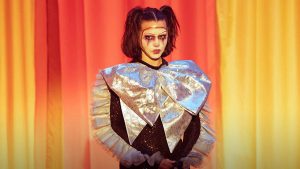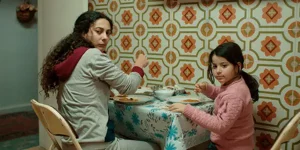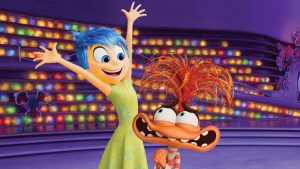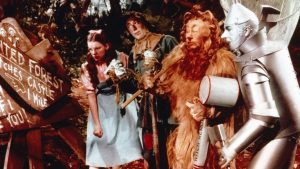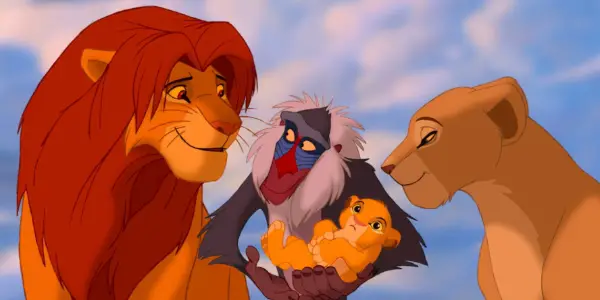
When I think of epic and intimate storytelling in animation, I think of The Lion King (1994). From its vast scope and devastating drama to its humor and energetic musical numbers, it’s been a staple of the Mouse House for thirty years now (can you believe that?). There’s something special about this film that sets it above the herd when it comes to its themes. Throughout this breakdown, I’m going to explore what about this picture really keeps viewers like myself coming back to it time and again.
A Brief Catch-Up
The story, loosely based off of Shakespeare‘s Hamlet, follows young Simba (Jonathan Taylor Thomas), son of and successor to Mufasa (James Earl Jones), who is king of the pride lands in Africa. Naively excited about the limitless ways he can get what he wants once he rules, Simba “just can’t wait to be king”. However, Simba’s sinister uncle Scar (Jeremy Irons) feels slighted by his being next in line. In response, Scar and his faithful hyena cohorts- Shenzi (Whoopi Goldberg), Banzai (Cheech Marin) and Ed (Jim Cummings) – conspire to start a stampede wherein Mufasa is ultimately killed. Thereafter, Simba is manipulated into blaming himself for the incident and banished from the pride lands. Years later, when his childhood friend Nala (Moira Kelly) tracks him down in the jungle, Simba (now voiced by Matthew Broderick) must confront his past, and learn what it truly takes to be a king.
source: Walt Disney Pictures
This magnificent picture still stands out as unique from the rest of Disney’s catalog for one big reason: its message. A lot of Disney animated fantasies often cycle through formulaic morals like “listen to your heart” or “wishes can come true”. However, this movie tells you, as Rafiki (Robert Guillaume): “The past can hurt. But the way I see it, you can either run from it, or learn from it”. It’s such a brutally honest message, and utterly crucial point to hammer home for kids, as it can open them up to larger conversations with their parents that can mold their moral compass for the better.
What Else Makes It Work?
I can’t go without mentioning the gigantic size and scale of the animation in this film. The amount of detail, the widescreen aspect ratio, and the depth of every image transports you right into the African savannah. This lends a genuinely epic quality to the events onscreen, in particular during a nerve-wracking stampede sequence wherein Simba struggles to avoid being trampled by wildebeest.
source: Walt Disney Pictures
Speaking of that detail, this movie is such a picturesque depiction of Africa. From shot one, it is evident that the animators did their homework regarding the aesthetic look of such a continent. Unlike the 2019 remake, which looks more like the camera was left in the sun for a week, this original version encompasses all the vibrant and diverse colors and landscaping down to the tiniest crumbs of dirt. You can just feel the life breathing through every blade of grass, or the leaping antelope.
I of course can’t go without spotlighting the music as well. This contains some of the biggest ear-worms in any Disney feature. Written by Tim Rice and Elton John, each number has the staying power to remain in my mind long after the credits have rolled. Particular favorites include “Be Prepared” (which absolutely gave me chills when I finally got to see this on the big screen in 2018), “Circle of Life”, and “I Just Can’t Wait to Be King”. Heck, even the lesser songs, “Hakuna Matata” and the Oscar-winning “Can You Feel the Love Tonight”, still put me in a good mood. And the score! Hans Zimmer, who won his first Academy Award for this soundtrack, utilizes all the instruments in his toolkit to create a melodic symphony that beautifully accompanies Simba’s journey without instructing you on how to feel. If you ever get a chance, I’d recommend going on YouTube and individually listening to “To Die For”, “This Land” and “King of Pride Rock”. Sonic beauty, I tell ya.
source: Walt Disney Pictures
Let’s Of Course Not Forget About the Characters
These folks are iconic for a single unifying reason: each perfectly contributes to Simba’s overarching journey of facing his past so he can move forward into a brighter future. Timon (voiced by Nathan Lane) and Pumbaa (Ernie Sabella), while their humor is hit-and-miss, don’t just function as the typical Disney comedic relief. Nor are they simply stand-ins for Rozencrantz and Guildenstern – a rather thin comparison if you’ve read or seen Hamlet before. Rather, they provide a temporarily-needed break from Simba’s responsibilities and guilt, as noted in Hakuna Matata”. But like true friends, when the time comes for Simba to change for the better and face his past, they prove themselves as true allies.
And let’s not forget this guy. Scar is easily not just the most unforgettable villain in Disney history, but one of the best in any animated film ever made. From his elegant, maniacal design to his equally despicable actions, he is simply pure evil. But what cements him as a top-tier antagonist is Jeremy Irons‘ magnificent voice work. Every syllable, every word, every consonant and vowel drips with a coolly calculated menace. From a company whose library is filled with iconic characters, Scar is a perfect coalition of animation, screenwriting, and casting.
source: Walt Disney Pictures
I also can’t overlook the king himself, Mufasa, voiced by the legendary James Earl Jones. His character may have the least amount of screen time out of anybody in the film, but he leaves the largest impact. Through the way he’s written, and Jones‘ poised delivery, you feel the impact of his wisdom long after he’s disappeared from the picture.
What It All Means to Me
I’d be lying if I said this movie hasn’t deepened in meaning in for me throughout my twenty-four years on this planet. While I won’t get too specific, I’ve definitely made a lot of mistakes, and experienced a lot of tragic, sometimes traumatic things. Time and again I’ve been compelled to face my past, and accept that I can’t change it but instead make a better future. I imagine it’s a similar impact that the movie has had on millions of others as well, that has allowed the movie to flourish and remain one of its distributors’ proudest achievements. I can also imagine that its message is the key reason to its almost billion-dollar gross in 1994, which made it the most successful animated movie ever for years. If you somehow haven’t seen this amazing achievement yet, make it next on your to-watch list.
Does content like this matter to you?
Become a Member and support film journalism. Unlock access to all of Film Inquiry`s great articles. Join a community of like-minded readers who are passionate about cinema – get access to our private members Network, give back to independent filmmakers, and more.

